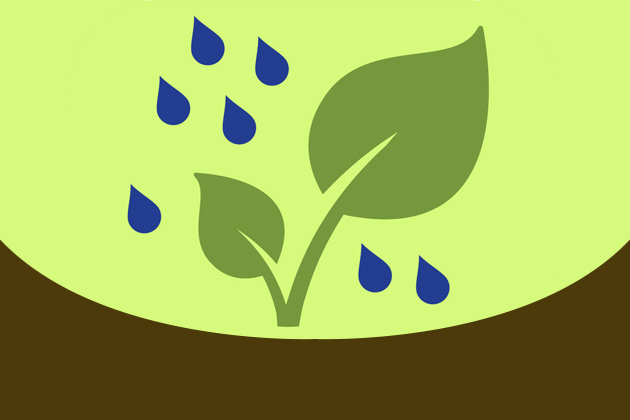The Center for Land Use Education and Research (CLEAR) in the College of Agriculture and Natural Resources has developed UConn’s first smart phone app that is designed for use by the general public. The smart phone Rain Garden app, now available from Apple’s iTunes App Store, is intended for use by landscapers, contractors, and homeowners to assist in designing, installing, and maintaining rain gardens.
A rain garden is a depression (about 6 inches deep) that collects storm water runoff from a roof, driveway, or yard and allows it to infiltrate into the ground. These gardens are typically planted with shrubs and perennials and can add colorful, landscaped areas to yards and office or school complexes. In addition to being attractive, they benefit the environment by preventing erosion, filtering runoff pollution, removing standing water, and creating a habitat for birds and butterflies.

David Dickson, assistant co-op extension educator-in-residence in the Department of Extension, says, “I started thinking that the contractors and landscapers we [CLEAR staff] work with probably have smart phones with them at all times … their trucks and their phones are what they use for an office … and I thought it would be great if they had a reference right there to help them with planning and laying out the gardens.”
Dickson talked it over with Mike Dietz, assistant co-op extension educator-in-residence, and Chet Arnold, cooperative extension educator, both in the Department of Extension, and the idea began to take shape. The Connecticut Sea Grant Program, a CLEAR partner, agreed to provide funding for the development of the app.
Dickson, Dietz, and Arnold knew they wanted to include everything from basic information about rain gardens to tips on picking a site, suggestions for native plants, and soil drainage maps. But they didn’t have the background to actually design the app, so they sought help from UConn’s Department of Computer Science and Engineering.
This app has national implications. In the future, this is how knowledge will be delivered.
That’s how Ph.D. student Alberto De la Rosa Algarin came into the picture. De la Rosa Algarin, who is studying information security, thought it would be a good problem-solving exercise: ”Even though it wasn’t directly tied to my research, I thought it would be a good opportunity to learn something new.”

“I didn’t know a lot about UConn’s commitment to being a green campus until I started working on the app,” he says. “I had seen the garden on the roof of the classroom building [Laurel Hall] but I hadn’t realized its importance, and now I’m learning about how the rain gardens around that building fit into the overall plan of creating a sustainable environment. It’s really interesting to see how all the pieces fit together.”
The biggest challenge from a technical standpoint was deciding how to set up reminders that involved weighing the options of two different methods, he says. “Ultimately we decided that we would use local notifications [controlled by the user] and not push notifications that would have to come from CLEAR. Other than that, creating the app just required tons of hours to iron out the details from the time I got involved last February until now.”
The app includes information on how to pick a site and size of garden, how to install a garden, plant selection guidelines focusing on native plants, and drainage charts. The information on site selection is available right down to individual locations, making planning specific to a specific plot of land, not just a general area.

While many extension programs around the country, including UConn, have focused on training landscapers and others on proper rain garden design and installation, this training often involves classroom instruction and guidebooks or printed presentation material. UConn’s utilization of a mobile app is revolutionary.
Mike O’Neill, director of cooperative extension at UConn, says, “The folks at CLEAR are not just being innovative locally. This app has national implications. In the future, this is how knowledge will be delivered.”
Landscapers will find the app particularly useful because it allows users to design and organize multiple gardens. And individual homeowners can search for plants that will enhance their particular landscapes, while the app will provide timely notifications to remind them about watering and plant care.
An added benefit to CLEAR is that when users export key information about their gardens to the Department of Extension, the staff will be able to quantify storm water volume treated by the gardens in the state, as well estimate pollutant load reductions.
All in all, it’s a lot of valuable information in a very small app that is now available through Apple’s iTunes App Store as “Rain Garden.” Although current content is focused primarily on Southern New England, the team hopes to release a national version of the app soon. There are also plans to make it available for Android devices later this year.
In the words of O’Neill, “These guys [from CLEAR] are creating a whole new path for how Cooperative Extension is going to look in the 21st century; that’s what’s so cool about this [app]. Everyone with an interest in rain gardens benefits, and it sets the stage for the future.”




